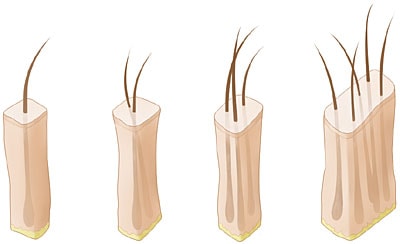

A person’s hair can make a first and lasting impression. While hair may appear to be a small detail in the scheme of things, it is a natural reflex to make a judgment based on the way someone colors and styles their hair, as well as how much or how little hair they have. As hair can be uniquely styled, it can be a form of personal and self-expression, and it allows a person to feel confident and self-assured. So when someone starts to lose his or her hair, it can be quite distressing. For men and women both, hair loss is something that is hard to accept. Thankfully, with the modern advances available today in hair restoration, it can be controlled, often reversed, and many times, restored. Our Korea-based doctors has successfully treated patients from early hair thinning to late stage baldness by providing personalized patient-specific treatments allowing for the best cosmetically pleasing results.
Each individual hair that is visible on the human head is called a hair shaft. Millions of dollars are spent styling, cutting and coloring these hairs despite the fact that they are considered “dead.” They don’t have a blood supply, nerves or muscles, so when it’s cut it doesn’t hurt or bleed. Each hair shaft grows from the hair follicle that lies beneath the scalp, and is considered the only living portion of the hair. The most important part of the hair follicle is the dermal papilla, which is responsible for the growth cycle of hair and the formation of new hair follicles. It receives nutrients from the surrounding blood supply. An interesting characteristic of hair is that, contrary to popular belief that it grows as individual strands, it actually grows out of the scalp in groups of 1-4 hairs. The reason is that hair follicles are not solitary structures, but are arranged in the skin in naturally occurring groups called “follicular units”.

On average, about 110,000 to 150,000 hair follicles exist on a normal scalp. 50-100 of those hairs are lost on any given day, while new hairs form in the same place as the old ones. That is why you may notice hairs on your pillow, back of your sweater, brush and even in the shower drain. The way our hair grows is in an asynchronous pattern consisting of 3 distinct stages. If our hair grew in a synchronous cycle, all our hairs would fall out at the same time, leaving us completely bald, while we waiting for the hair to return. As a person gets older, the timing of these growth cycles change, where the growth (anagen) stage becomes shorter and the resting (telogen) stage lasts longer.

Anagen Phase: The first phase of hair growth is the anagen phase. This is the phase where the hair is actively growing. Around 85-90% of hair is in this phase at any point in time and can last anywhere from 2 to 6 years. Typically, hair growth for most individuals is close to half an inch each month. People who have difficulty growing their hair long have naturally shorter growth periods.

Catagen Phase: At the end of the anagen phase, hair enters what is known as the catagen phase. This is a transitional phase that can last for about 2 weeks. It occurs when the bulb detaches from the normal blood supply, causing the hair shaft to be pushed up.

Telogen Phase: The telogen phase is the final phase in the hair growth cycle lasting 3 to 4 months, and is commonly known as the “resting” phase where there is no additional growth. At the end of this phase, the hair follicle re-enters the anagen phase and a new hair begins to form. If the old hair has not already been shed, the new hair pushes out the old one. Approximately 10-15% of hair is in this phase at once.
The general medical term given for hair loss is alopecia, and it happens when these hair growth stages are interrupted. Some hair loss conditions are temporary while others are permanent. For many men and women, their hair loss is due to androgenetic alopecia (male and female pattern baldness), and is driven by three factors - androgens (male hormones), genetics and age. Genetic hair loss can come from either side of your family and can skip a generation. Hereditary hair loss is very common, affecting about 50 million men and 30 million women in the U.S. alone. Read more about hair loss in men and hair loss in women.
Other conditions that can disrupt hair growth cycles or even destroy hair follicles include certain medical and scalp conditions, nutritional deficiencies, medications, hormonal imbalances, physical injury, and even hair care practices and styles. Once hair loss begins, it is usually a slow, gradual process that may occur in certain regions of the scalp, or all over. Unfortunately, once hair loss is detected by the naked eye, almost 50% of hair in that region has been lost. This is usually when panic sets in, as the person never realized they were losing their hair, until it became noticeable.
There are many myths regarding hair loss, such as shampooing or hats causing hair to fall out. Find out the truth behind these myths here.
Many hair loss conditions are reversible simply by removing the causes and/or by using nonsurgical methods to stabilize hair loss, improve the quality of the hair and regrow them. Other hair loss disorders cannot be treated nonsurgically due to the degree and permanence of hair loss. In those cases, hair transplant surgery may be considered. Hair loss disorders that our doctors treat include:
Non-Scarring Alopecia
Male and Female Pattern Baldness (Androgenetic Alopecia)
Alopecia Areata
Telogen Effluvium
Anagen Effluvium
Trichotillomania (early stage)
Traction Alopecia (early stage)
Scarring (Cicatricial) Alopecia
Trichotillomania (late stage)
Traction Alopecia (late stage)
The hair loss prevention and restoration industry has exploded in recent years. Men and women worldwide spend billions of dollars per year on shampoos, vitamins and nutritional supplements, hairpieces, lotions and pills. Despite all the time and money spent on hair loss products, they may never see the results they want. New advances in medical and surgical techniques and technology have made it possible for both men and women to slow their hair loss, reverse and restore it. Our doctors can prescribe the latest medication in order to halt your hair loss. Read more about available medications.

For those patients that require surgery, our doctors offer the latest in Follicular Unit Transplant (FUT) and Follicular Unit Extraction (FUE), the most advanced minimally invasive procedure to date. While 95%-98% of men who suffer from male pattern baldness is due to age, hormones and genetics, women often times may have multiple causes for their hair loss, therefore a multi-therapeutic approach to combating hair loss may be necessary to effectively slow down or stop hair loss, improve the quality of hair you have, and even restore hair that has been lost. See the hair transplant growth timeline here.

If you are suffering from slow or rapid hair loss and your hair thinning is becoming noticeable, or if you have balding that you wish to cover with new hair growth, we invite you to contact our hair restoration service today. You can find the answers to the most frequently asked questions here. Your doctors in Korea will provide a comprehensive medical and hair loss history, and scalp and hair analysis that will allow them to provide each patient with an accurate diagnosis so that a patient-specific treatment plan can be put into action. Contact us now.

Please send us your email address, and one of our representatives will personally contact you as soon as possible.
Your email address will never be sold or spammed.